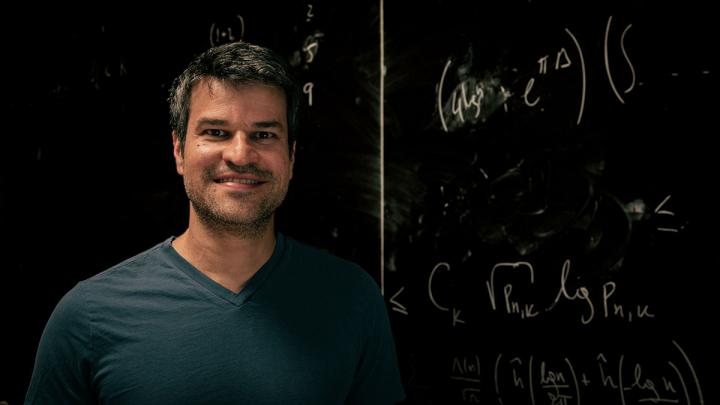
Everyone learns maths in school, but the methods used in mathematical research can be opaque to a non-specialist, with most people not really understanding how this type of work is conducted. Emanuel Carneiro, a research scientist with the ICTP Mathematics section (and a former Simon’s Associate), delves into the life of a mathematician. Part 1 of Carneiro's interview describes his upbringing and education in Brazil; you can read it here.
What is your research about?
My work is on harmonic analysis (essentially the mathematical study of several types of oscillatory phenomena in nature) and some of its applications to number theory. This is the pure mathematics that comes at the very beginning of the chain of some concepts and phenomena in the real world, such as telecommunications, biomedical equipment, and all types of signal processing and compactification of data.
Many of the things that we do are to understand oscillatory phenomena using the language of mathematics.
In this chain, there's the pure mathematician, applied mathematician, applied engineer, then the engineers who construct something. I’m the first guy in the chain, thinking about conceptual problems, working with integrals, operators and functions. Many of the things that we do are to understand oscillatory phenomena using the language of mathematics. These phenomena appear in many areas of mathematics, such as number theory, probability, partial differential equations and approximation theory. I like to work in these areas, although I don't consider myself an expert in them. I know a little, but I like to get together with people who know more than me in these other fields. This is where the real magic happens.
How do mathematicians from different subfields work together on a problem?
Some of the most interesting mathematics happens when you combine researchers from different fields. Mathematics is very old and classical, but we have actually advanced a lot, and people do mix ideas from different subfields.
For this type of mixing, you need to have some understanding of your field, and a basic understanding of a neighbouring field. You start analysing situations; throwing ideas on the table. Mathematicians are precise in what they do. A chemist, for example, can propose an experiment. They have a hypothesis and expect a particular result, which they then verify. Mathematics is not like this.
There are many open problems in mathematics, and you don't know which ones you're going to be able to solve. You're like an eagle flying, looking for the perfect situation to attack. Once you see something, some opening in one of these problems, you can swoop in.
What makes a good mathematics project?
I tell my students that a good project has to have certain important characteristics. It has to address an open problem; it has to be interesting to some community, i.e., someone has to care about it; and it must be non-trivial. It can't just be a trivial modification of something people did before.
A project also has to be a beautiful thing that drives your own interest. And crucially, the project must be something you know how to do. The Riemann hypothesis is open, non-trivial, interesting and beautiful, but I just don't know how to do it. However, once you have all these factors together, you have a beautiful mathematical project.
How do you know how to start a particular project?
The real answer is that you don't know for sure. You have to have several projects percolating in your brain. You follow recent research, a new paper is published that gives you an idea, and you have to be thinking about the situation for a while, and discussing it with friends. There is a point in a project where you're trying to do something, and it clicks. At that point, you know something will come out of it, even if you don't exactly know its final format.
Can you give an example of this percolation process?
I did a project in 2015, which I presented at a conference. A professor came to me afterwards and asked me if I could apply my work to another situation. His situation seemed to be simpler, so I tried it, but it turned out not to be so simple. It was roughly related to Heisenberg's Uncertainty Principle. I made some progress. It turned out to be a worthy problem, and I made a number of advances, but not enough to release or to publish. I put the project aside and thought about it from time to time.
Last year we had a big group of associates here. I had two postdocs, one student, and with others, we were seven people, all of us from South America; Brazil, Argentina and Chile. We were meeting separately all the time to discuss different problems, and I said, “Why don’t we all meet to spit ball some problems we have, and discuss them together.”
This approach worked very nicely in this case. I presented my project from 2015 to see if they could help with it. We worked on the problem, first thinking about it, then making more and more progress. Over the last year, the project has evolved into something very interesting. Now we have a paper describing, to a good level of precision, the situation we wanted to describe.
How do you train new researchers?
One of the things I'm most proud of are my students; I’ve had seven PhD students that graduated, and two current ones. I like to work with my students as partners. I train my students as fast as I can, so they can become my research partners and we can think about interesting projects together.
The sort of situations I like to study are usually either simple or motivated by something simple; some simple object. My students don’t have to study for three years to learn a language in which I will then assign their thesis problem. I can actually assign the problem straight away, and they will understand what it is about. The difficulty is not understanding the problem, but in solving it. In other subfields of mathematics, there are more difficulties related to learning the language, and people spend a couple of years in grad school to just understand the language.
Can you talk about a recent collaboration?
I like very much to collaborate, so most of my papers are written in collaboration. One of my projects lies between analysis and number theory; with two number theorists from the United States, and a former student of mine, now a professor in PUC - Peru. We aimed to understand the so-called pair correlation of the zeros of the Riemann zeta function, related to a famous problem in number theory called the Riemann hypothesis. A million dollars have been offered to whoever solves it.
This is the goal, to say something non-trivial about a situation, which could open up something beautiful; something that you can do.
The Riemann hypothesis is a statement about proving that all the non-trivial zeros of a certain complex function, called the Riemann zeta function, lie on a certain line. It’s further been conjectured that these zeros are distributed according to a certain model of random matrices. So, there's this whole connection between number theory, random matrix theory and mathematical physics, which is a very beautiful thing. There is an equivalent formulation of the latter problem, called Montgomery's pair correlation conjecture, in terms of a special function called Montgomery's F-function, where the goal becomes to understand the pointwise behaviour of this function. We developed a new Fourier optimization framework to determine the best-up-to-date upper and lower bounds for averages of this F-function.
One of the nice things about mathematics is that even when you can’t solve a problem, you can always find another nice similar situation around it that’s still meaningful. By solving that, you can maybe capture a little of the non-triviality of the original problem. This is the goal, to say something non-trivial about a situation, which could open up something beautiful; something that you can do. That's the motivation.
LINKS:
[1] E. Carneiro, V. Chandee, A. Chirre and M. Milinovich, On Montgomery's pair correlation conjecture: a tale of three integrals, Journal für die reine un angewandte Mathematik (Crelle's journal), vol. 786 (2022), 205-243. https://doi.org/10.1515/crelle-2021-0084
[2] E. Carneiro, M. Milinovich and A. P. Ramos, Fourier optimization and Montgomery's pair correlation conjecture, preprint at https://arxiv.org/abs/2310.01913

















